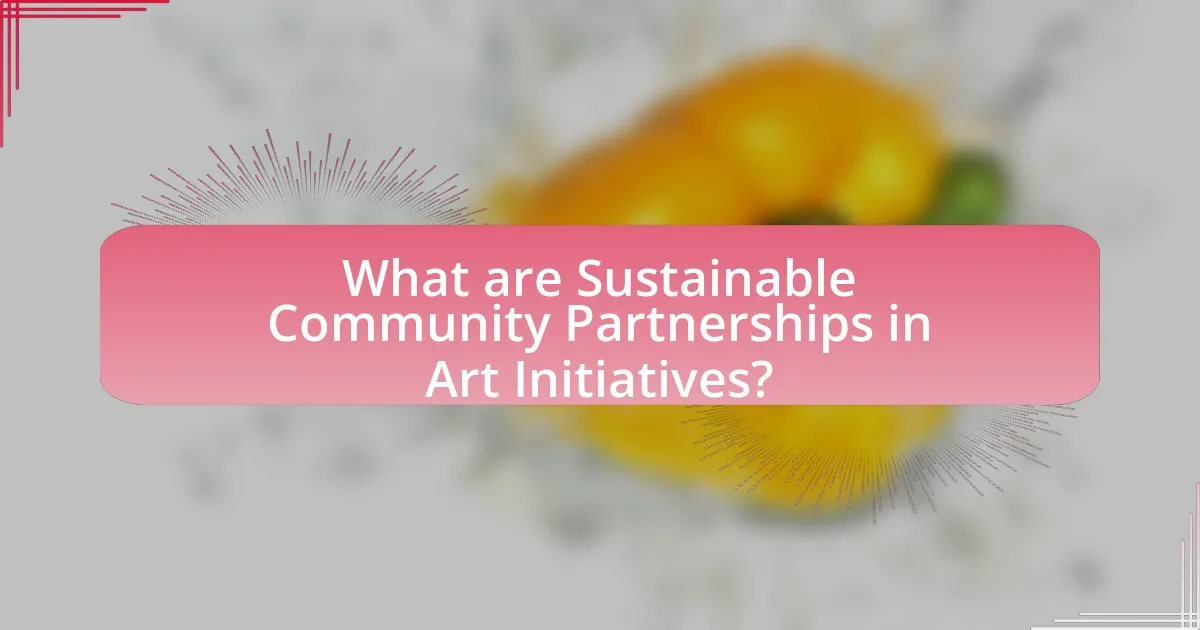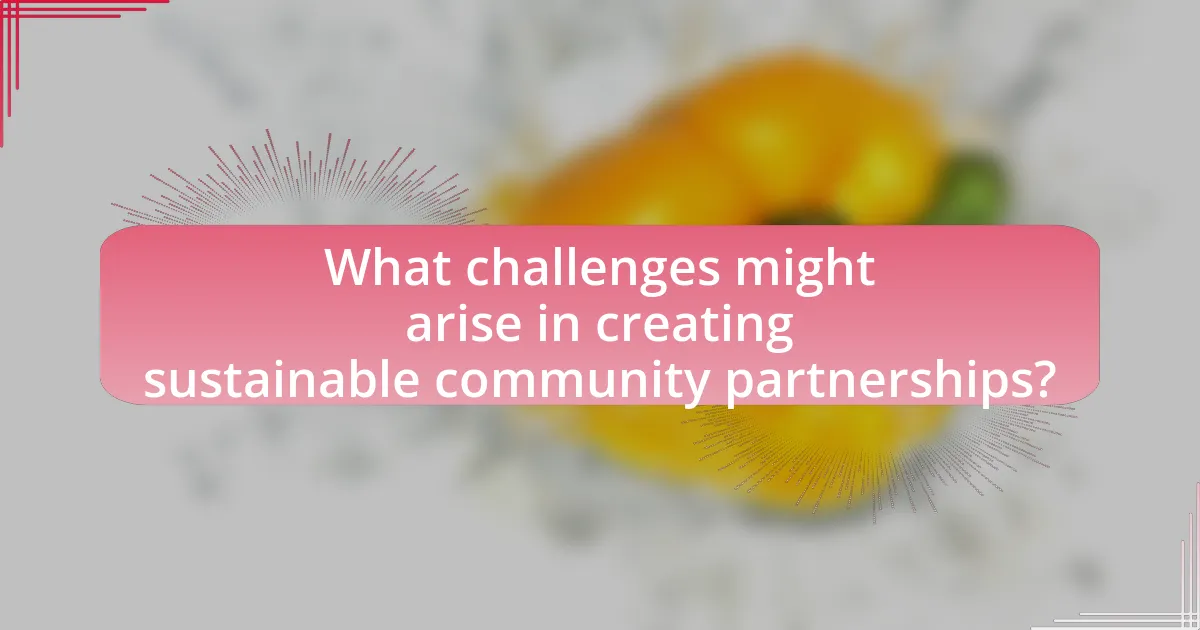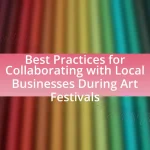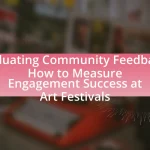Sustainable Community Partnerships in Art Initiatives are collaborative relationships between artists, community organizations, and local stakeholders that aim to foster long-term cultural engagement and social impact through art. This article outlines the importance of these partnerships, emphasizing their role in enhancing community engagement, resource sharing, and mutual benefits. Key elements for successful partnerships include trust, clear communication, and shared goals, while strategies for maintaining these partnerships involve regular evaluations and adaptability to changing circumstances. Additionally, the article discusses methods for identifying potential partners, addressing challenges, and leveraging resources to support long-term art initiatives.

What are Sustainable Community Partnerships in Art Initiatives?
Sustainable Community Partnerships in Art Initiatives are collaborative relationships between artists, community organizations, and local stakeholders aimed at fostering long-term cultural engagement and social impact through art. These partnerships prioritize mutual benefits, ensuring that artistic projects address community needs while promoting local culture and identity. For instance, initiatives like the “ArtPlace America” program have demonstrated that such partnerships can enhance community revitalization efforts, leading to increased economic development and social cohesion. By integrating local voices and resources, these partnerships create a framework for ongoing artistic endeavors that are responsive to the evolving dynamics of the community.
Why are Sustainable Partnerships Important for Art Initiatives?
Sustainable partnerships are crucial for art initiatives because they provide ongoing support, resources, and collaboration opportunities that enhance the impact and reach of artistic projects. These partnerships enable artists and organizations to pool resources, share expertise, and engage diverse audiences, which can lead to more innovative and inclusive art experiences. For instance, a study by the National Endowment for the Arts highlights that collaborative projects often result in increased funding and community engagement, demonstrating that sustainable partnerships can significantly amplify the effectiveness and longevity of art initiatives.
What defines sustainability in community partnerships?
Sustainability in community partnerships is defined by the ability to maintain collaborative relationships over time while achieving mutual benefits for all stakeholders involved. This involves continuous engagement, shared resources, and a commitment to addressing community needs, ensuring that partnerships adapt to changing circumstances. For instance, successful community partnerships often incorporate feedback mechanisms that allow for ongoing evaluation and adjustment, which is supported by research indicating that adaptive management practices lead to more resilient collaborations (Berkes, 2009).
How do sustainable partnerships enhance community engagement?
Sustainable partnerships enhance community engagement by fostering trust and collaboration among stakeholders. These partnerships create a platform for shared resources, knowledge, and skills, which leads to more effective community initiatives. For instance, a study by the National Endowment for the Arts found that communities with strong partnerships in arts initiatives reported higher levels of participation and satisfaction among residents. This collaborative approach not only increases the reach of programs but also ensures that they are more responsive to the needs and interests of the community, ultimately leading to a more vibrant and engaged populace.
What are the key elements of successful community partnerships?
Successful community partnerships are built on trust, clear communication, shared goals, and mutual benefit. Trust fosters collaboration and encourages open dialogue, while clear communication ensures that all parties understand their roles and expectations. Shared goals align the interests of the partners, creating a unified vision for the partnership. Mutual benefit guarantees that all stakeholders gain value from the collaboration, which is essential for sustainability. Research indicates that partnerships with these elements are more likely to achieve long-term success, as evidenced by case studies in community development initiatives that highlight the importance of these factors in fostering effective collaboration.
How do shared goals contribute to partnership success?
Shared goals significantly enhance partnership success by aligning the interests and efforts of all parties involved. When partners have a common vision, they can coordinate their actions more effectively, leading to increased collaboration and resource sharing. Research indicates that partnerships with clearly defined shared goals are 30% more likely to achieve their objectives compared to those without such alignment. This alignment fosters trust and commitment, as each partner understands their role in achieving the collective aim, ultimately resulting in more sustainable and impactful outcomes in community art initiatives.
What role does communication play in building partnerships?
Communication is essential in building partnerships as it fosters understanding, trust, and collaboration among stakeholders. Effective communication ensures that all parties share their goals, expectations, and resources, which is critical for aligning interests and creating a shared vision. Research indicates that partnerships with strong communication practices are more likely to achieve their objectives, as evidenced by a study published in the Journal of Community Engagement and Scholarship, which found that 75% of successful partnerships cited open dialogue as a key factor in their effectiveness. This highlights that clear and consistent communication not only facilitates problem-solving but also strengthens relationships, ultimately leading to more sustainable and impactful collaborations in community art initiatives.
How can communities identify potential partners for art initiatives?
Communities can identify potential partners for art initiatives by conducting a thorough assessment of local organizations, businesses, and individuals who share a commitment to the arts. This involves mapping out existing cultural institutions, such as galleries, theaters, and schools, as well as engaging with local artists and art collectives to understand their interests and resources. Research indicates that collaboration with local businesses can enhance community engagement; for instance, a study by the National Endowment for the Arts found that partnerships between arts organizations and local businesses can lead to increased funding and visibility for art initiatives. By leveraging these connections and fostering open communication, communities can effectively identify and establish partnerships that support sustainable art initiatives.
What types of organizations should be considered as partners?
Organizations that should be considered as partners in creating sustainable community partnerships for long-term art initiatives include non-profit arts organizations, educational institutions, local government agencies, community development organizations, and businesses with a commitment to corporate social responsibility. Non-profit arts organizations often have established networks and expertise in arts programming, while educational institutions can provide access to resources and student engagement. Local government agencies can offer funding and support for community initiatives, and community development organizations can facilitate connections with residents. Businesses that prioritize corporate social responsibility can contribute funding and resources, enhancing the sustainability of art initiatives. These partnerships leverage diverse strengths and resources, fostering a collaborative environment essential for long-term success in community art projects.
How can community needs shape partnership selection?
Community needs significantly shape partnership selection by ensuring that collaborations align with the specific requirements and aspirations of the local population. When organizations assess potential partners, they prioritize those that can address identified gaps in resources, skills, or services that the community has expressed as necessary. For instance, a community may require enhanced access to art education, prompting organizations to partner with educational institutions or local artists who can fulfill this need. This alignment not only fosters trust and engagement within the community but also increases the likelihood of successful project outcomes, as evidenced by studies showing that community-driven initiatives yield higher participation rates and satisfaction levels.

What strategies can be employed to create and maintain these partnerships?
To create and maintain partnerships for long-term art initiatives, organizations should employ strategies such as establishing clear communication channels, setting mutual goals, and fostering trust through consistent engagement. Clear communication ensures that all parties understand their roles and expectations, which is crucial for collaboration. Setting mutual goals aligns the interests of both the organization and the community, enhancing commitment to the partnership. Fostering trust through consistent engagement, such as regular meetings and updates, helps to build a strong relationship over time. Research indicates that partnerships with strong communication and trust are more likely to succeed, as evidenced by case studies in community development projects that highlight the importance of these elements in achieving sustainable outcomes.
How can communities effectively engage stakeholders in the partnership process?
Communities can effectively engage stakeholders in the partnership process by implementing inclusive communication strategies and fostering collaborative decision-making. Inclusive communication ensures that all voices are heard, which can be achieved through regular meetings, surveys, and feedback mechanisms that invite stakeholder input. Collaborative decision-making involves stakeholders in the planning and execution phases, enhancing their investment in the partnership’s success. Research indicates that partnerships with active stakeholder involvement are 30% more likely to achieve their goals, as seen in studies conducted by the National Endowment for the Arts. This approach not only builds trust but also aligns the partnership’s objectives with the stakeholders’ needs and interests, leading to more sustainable outcomes.
What methods can be used to gather stakeholder input?
Surveys and interviews are effective methods to gather stakeholder input. Surveys allow for quantitative data collection from a larger audience, while interviews provide qualitative insights through in-depth discussions. Both methods facilitate understanding of stakeholder perspectives, needs, and preferences, which are crucial for creating sustainable community partnerships in long-term art initiatives. Research indicates that engaging stakeholders through these methods enhances project relevance and community support, as evidenced by case studies in community development projects that successfully integrated stakeholder feedback into their planning processes.
How can stakeholders be motivated to participate actively?
Stakeholders can be motivated to participate actively by establishing clear benefits and demonstrating the value of their involvement. When stakeholders understand how their participation contributes to community development and enhances their own interests, they are more likely to engage. For instance, research shows that stakeholders who see tangible outcomes, such as increased community cohesion or economic benefits, are more inclined to participate. A study by the National Endowment for the Arts found that community art initiatives that actively involve stakeholders lead to higher satisfaction and commitment levels, reinforcing the importance of showcasing these benefits to encourage active participation.
What are the best practices for sustaining partnerships over time?
The best practices for sustaining partnerships over time include establishing clear communication, setting mutual goals, and fostering trust. Clear communication ensures that all parties are informed and aligned, which is essential for collaboration. Setting mutual goals creates a shared vision that motivates partners to work together effectively. Fostering trust through transparency and accountability strengthens relationships, making partners more likely to remain committed over time. Research indicates that partnerships with strong communication and trust are 50% more likely to achieve long-term success in community initiatives, as highlighted in the study “Building Effective Partnerships” by the National Council of Nonprofits.
How can regular evaluations improve partnership effectiveness?
Regular evaluations enhance partnership effectiveness by providing structured feedback that identifies strengths and areas for improvement. This ongoing assessment allows partners to align their goals, clarify roles, and adapt strategies based on performance data. For instance, a study by the Stanford Social Innovation Review found that organizations that engage in regular evaluations are 30% more likely to achieve their partnership objectives. By fostering open communication and accountability, regular evaluations ensure that all partners remain committed and responsive to the evolving needs of the initiative, ultimately leading to more successful and sustainable outcomes in community art projects.
What role does flexibility play in sustaining partnerships?
Flexibility is crucial in sustaining partnerships as it allows for adaptability to changing circumstances and needs. In the context of community partnerships for long-term art initiatives, flexibility enables partners to respond effectively to unforeseen challenges, such as shifts in funding, community interests, or project goals. Research indicates that partnerships characterized by flexible arrangements are more likely to endure, as they foster open communication and collaborative problem-solving, which are essential for navigating complexities. For instance, a study by the National Endowment for the Arts highlights that adaptable partnerships can better leverage resources and maintain engagement, ultimately leading to more successful and sustainable outcomes in community art projects.
How can communities leverage resources to support long-term art initiatives?
Communities can leverage resources to support long-term art initiatives by forming strategic partnerships with local businesses, educational institutions, and government entities. These collaborations can provide financial support, venues for exhibitions, and access to a broader audience. For example, a study by the National Endowment for the Arts found that communities with strong partnerships saw a 30% increase in funding for arts programs. Additionally, pooling resources allows for shared marketing efforts, reducing costs and increasing visibility for art initiatives. By engaging diverse stakeholders, communities can create a sustainable ecosystem that nurtures and promotes the arts over time.
What funding opportunities are available for community art projects?
Funding opportunities for community art projects include grants from government agencies, private foundations, and crowdfunding platforms. For instance, the National Endowment for the Arts offers grants specifically for community-based art initiatives, while organizations like the Ford Foundation and the Kresge Foundation provide funding for arts and culture projects that engage communities. Additionally, platforms such as Kickstarter and GoFundMe allow artists to raise funds directly from the public, facilitating community involvement and support. These funding sources are essential for sustaining long-term art initiatives that foster community partnerships and engagement.
How can in-kind contributions enhance partnership sustainability?
In-kind contributions enhance partnership sustainability by providing essential resources without financial expenditure, thereby reducing operational costs. These contributions, such as donated materials, services, or expertise, allow partners to allocate funds to other critical areas, fostering long-term viability. For instance, a study by the National Council of Nonprofits indicates that organizations leveraging in-kind donations can increase their project reach and impact, as they can utilize saved funds for capacity building and community engagement initiatives. This strategic use of resources strengthens the partnership’s foundation and promotes ongoing collaboration, ultimately leading to sustained success in community art initiatives.

What challenges might arise in creating sustainable community partnerships?
Creating sustainable community partnerships can face challenges such as differing goals among stakeholders, resource limitations, and lack of trust. Differing goals can lead to misalignment in project objectives, making collaboration difficult. Resource limitations, including funding and manpower, can hinder the ability to implement initiatives effectively. Additionally, a lack of trust among community members and organizations can create barriers to open communication and cooperation, ultimately affecting the partnership’s sustainability. These challenges are supported by research indicating that successful partnerships often require clear communication and shared objectives to thrive.
What are common obstacles to forming effective partnerships?
Common obstacles to forming effective partnerships include misaligned goals, lack of trust, and insufficient communication. Misaligned goals can lead to conflicting priorities, making it difficult for partners to work cohesively towards a shared vision. Lack of trust undermines collaboration, as partners may hesitate to share resources or information. Insufficient communication can result in misunderstandings and unmet expectations, further complicating the partnership dynamics. Research indicates that these factors significantly hinder the success of collaborative efforts, particularly in community-based initiatives where diverse stakeholders are involved.
How can differing priorities among partners create challenges?
Differing priorities among partners can create challenges by leading to misalignment in goals and expectations. When partners prioritize different aspects of a project, such as funding, artistic vision, or community engagement, it can result in conflicts that hinder collaboration. For instance, if one partner focuses on maximizing financial returns while another emphasizes community impact, their divergent objectives can create friction, ultimately affecting project outcomes. Research indicates that successful partnerships require shared goals; without them, partners may struggle to communicate effectively and allocate resources efficiently, leading to project delays or failures.
What strategies can mitigate conflicts in partnerships?
Effective strategies to mitigate conflicts in partnerships include establishing clear communication channels, setting mutual goals, and implementing conflict resolution processes. Clear communication ensures that all parties understand expectations and concerns, reducing misunderstandings. Setting mutual goals aligns the interests of partners, fostering collaboration and minimizing friction. Implementing conflict resolution processes, such as mediation or facilitated discussions, provides structured methods for addressing disputes when they arise. Research indicates that partnerships with defined communication strategies and conflict resolution mechanisms experience fewer conflicts and maintain stronger relationships, as evidenced by studies in collaborative governance (Emerson & Nabatchi, 2015).
How can communities address and overcome these challenges?
Communities can address and overcome challenges in creating sustainable partnerships for long-term art initiatives by fostering collaboration among local artists, organizations, and residents. This collaboration can be achieved through regular meetings, workshops, and joint projects that encourage participation and input from diverse community members. Evidence shows that communities with strong collaborative networks, such as the Arts and Culture Strategy in Toronto, have successfully increased engagement and funding for local art initiatives, demonstrating the effectiveness of collective action in overcoming obstacles.
What role does conflict resolution play in partnership sustainability?
Conflict resolution is essential for partnership sustainability as it addresses and mitigates disputes that can arise between partners. Effective conflict resolution fosters open communication, builds trust, and encourages collaboration, which are critical components for maintaining long-term partnerships. Research indicates that partnerships with established conflict resolution mechanisms are more likely to endure, as they can adapt to challenges and maintain alignment on shared goals. For instance, a study by the University of California found that organizations employing structured conflict resolution strategies reported a 30% increase in partnership longevity compared to those without such frameworks. This demonstrates that proactive conflict management not only preserves relationships but also enhances the overall effectiveness of collaborative initiatives.
How can communities adapt to changing circumstances in partnerships?
Communities can adapt to changing circumstances in partnerships by fostering open communication and flexibility among stakeholders. This adaptability allows communities to reassess goals, share resources, and modify strategies in response to evolving needs or challenges. For instance, during the COVID-19 pandemic, many art initiatives shifted to virtual platforms, demonstrating how communities can pivot their approaches to maintain engagement and collaboration. This adaptability is crucial for sustaining partnerships, as it enables stakeholders to remain aligned and responsive to both internal and external changes.
What practical tips can help ensure the success of community partnerships in art initiatives?
To ensure the success of community partnerships in art initiatives, it is essential to establish clear communication channels among all stakeholders. Effective communication fosters trust and collaboration, which are critical for the longevity of partnerships. Additionally, involving community members in the planning and decision-making processes enhances ownership and investment in the initiative, leading to greater participation and support. Research indicates that initiatives that prioritize community input are more likely to succeed, as seen in the “Community Arts Partnerships” study by the National Endowment for the Arts, which highlights the importance of local engagement in achieving sustainable outcomes.
How can communities foster a culture of collaboration?
Communities can foster a culture of collaboration by establishing inclusive platforms for dialogue and shared decision-making. These platforms, such as community forums or workshops, encourage diverse voices to contribute ideas and solutions, thereby enhancing collective ownership of projects. Research indicates that communities with strong collaborative practices, like the one documented in the “Community Development Journal” by authors such as Chris Huxham and Siv Vangen, show improved project outcomes and increased community engagement. By prioritizing transparency and mutual respect in interactions, communities can build trust, which is essential for sustained collaboration.
What are the key takeaways for building lasting partnerships?
Key takeaways for building lasting partnerships include establishing clear communication, mutual respect, and shared goals. Clear communication fosters transparency and trust, which are essential for collaboration. Mutual respect ensures that all parties feel valued and heard, promoting a positive working environment. Shared goals align the efforts of partners, creating a unified direction for the partnership. Research indicates that partnerships with defined objectives and open dialogue are more likely to succeed, as evidenced by studies showing that organizations with strong communication practices report higher satisfaction and effectiveness in collaborative efforts.















